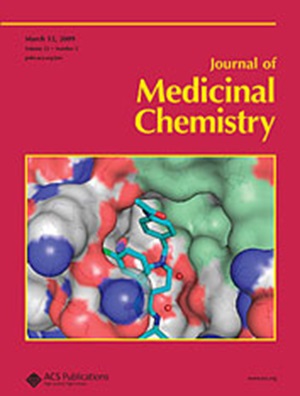Photo-Activated Ferrocene-Iridium(III) Prodrug Induces Immunogenic Cell Death in Melanoma Stem Cells
IF 6.8
1区 医学
Q1 CHEMISTRY, MEDICINAL
引用次数: 0
Abstract
Cancer stem cells (CSCs) are key contributors to tumor resistance, recurrence, and metastasis. Conventional chemotherapy often fails to target and eradicate CSCs, significantly impairing their therapeutic efficacy. Herein, we design and synthesize a photoactivated ferrocene-iridium(III) complex (Ir-3) to achieve immunotherapy against melanoma cells (including stem cells). In short, Ir-3 effectively targets mitochondria and dissociates under light irradiation to produce a cytotoxic Ir(III) photosensitizer and Fe2+ ions. They can generate reactive oxygen species by the Fenton reaction, robustly induce ferroptosis and autophagy, and eventually trigger immunogenic cell death in melanoma cells (including stem cells). Furthermore, under light exposure, Ir-3 effectively inhibits stem cell-related properties and promotes macrophage-mediated phagocytosis of melanoma stem cells. For in vivo studies, Ir-3 is encapsulated in DSPE-PEG 2000 to form tumor-targeting Ir-3@PEG nanoparticles. After photoactivation, Ir-3@PEG can significantly inhibit primary and distant tumors, effectively inhibit the stemness of melanoma stem cells, and induce innate and adaptive immune responses.

光活化二茂铁铱(III)前药诱导黑色素瘤干细胞免疫原性细胞死亡
肿瘤干细胞(CSCs)是肿瘤抵抗、复发和转移的关键因素。常规化疗往往不能靶向和根除CSCs,显著降低其治疗效果。在此,我们设计并合成了一种光激活的二茂铁-铱(III)复合物(Ir-3),以实现对黑色素瘤细胞(包括干细胞)的免疫治疗。简而言之,Ir-3有效地靶向线粒体,并在光照下解离,产生细胞毒性Ir(III)光敏剂和Fe2+离子。它们可以通过芬顿反应产生活性氧,强烈诱导铁凋亡和自噬,最终引发黑色素瘤细胞(包括干细胞)的免疫原性细胞死亡。此外,在光照下,Ir-3能有效抑制干细胞相关特性,促进巨噬细胞介导的黑色素瘤干细胞吞噬。在体内研究中,Ir-3被封装在DSPE-PEG 2000中形成肿瘤靶向Ir-3@PEG纳米颗粒。Ir-3@PEG经光激活后,能显著抑制原发和远处肿瘤,有效抑制黑色素瘤干细胞的干性,诱导先天和适应性免疫反应。
本文章由计算机程序翻译,如有差异,请以英文原文为准。
求助全文
约1分钟内获得全文
求助全文
来源期刊

Journal of Medicinal Chemistry
医学-医药化学
CiteScore
4.00
自引率
11.00%
发文量
804
审稿时长
1.9 months
期刊介绍:
The Journal of Medicinal Chemistry is a prestigious biweekly peer-reviewed publication that focuses on the multifaceted field of medicinal chemistry. Since its inception in 1959 as the Journal of Medicinal and Pharmaceutical Chemistry, it has evolved to become a cornerstone in the dissemination of research findings related to the design, synthesis, and development of therapeutic agents.
The Journal of Medicinal Chemistry is recognized for its significant impact in the scientific community, as evidenced by its 2022 impact factor of 7.3. This metric reflects the journal's influence and the importance of its content in shaping the future of drug discovery and development. The journal serves as a vital resource for chemists, pharmacologists, and other researchers interested in the molecular mechanisms of drug action and the optimization of therapeutic compounds.
 求助内容:
求助内容: 应助结果提醒方式:
应助结果提醒方式:


